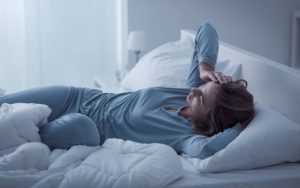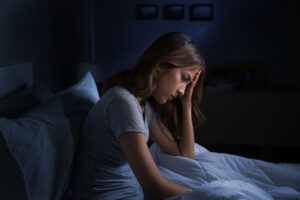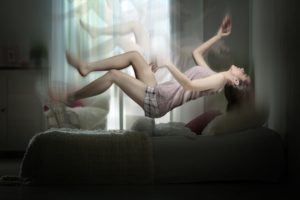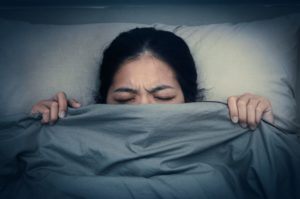REM Sleep Behavior Disorder
- REM sleep behavior disorder causes people to act out their dreams.
- Symptoms include vivid or frightening dreams, physical movements, and vocalizations during sleep.
- REM sleep behavior disorder often coexists with other neurological conditions.
- A sleep study and treatment can help reduce symptoms and prevent injury.
Normally during REM sleep, the body experiences temporary paralysis of most of the body’s muscles while the brain is active and dreaming. This allows us to dream quietly and safely throughout the night. For individuals with REM sleep behavior disorder, paralysis does not occur during the REM stage. Instead, their body and voice perform their dreams while they remain asleep.
Less than one percent of people are estimated to have REM sleep behavior disorder . It usually begins after age 50, and the disease is associated with other neurodegenerative disorders, including Parkinson’s disease, Lewy body dementia, and multiple system atrophy. Symptoms often worsen with time. The condition usually requires treatment because it increases the risk of injury to oneself and their bed partner.
Is Your Troubled Sleep a Health Risk?
A variety of issues can cause problems sleeping. Answer three questions to understand if it’s a concern you should worry about.
What Is REM Sleep Behavior Disorder?
REM sleep behavior disorder is a condition characterized by sudden body movements and vocalizations while a person experiences vivid dreams during REM sleep . It is a specific type of parasomnia, which describes abnormal behaviors during sleep.
During normal REM sleep, the body experiences temporary muscle paralysis, known as atonia, while the brain shows activity similar to wakefulness. Blood pressure rises, breathing becomes irregular, and the eyes dart in all directions rapidly (hence, the term “rapid eye movement”). The temporary paralysis of REM sleep allows us to dream safely, lying still while the brain is active. This paralysis involves most skeletal muscles and excludes muscles that help us breathe, digest, and some muscles of the eyes. REM sleep accounts for about 25 percent of a total night’s sleep, with most of it taking place during the second half of the night.
For individuals with REM sleep behavior disorder, normal muscle paralysis does not occur, enabling the person to physically act out their dreams. REM sleep behavior disorder can manifest as small muscle twitches and quiet sleep talking to loud shouting, punching, kicking, grabbing their bed partner, and jumping out of bed. Interestingly, the dreams associated with REM sleep behavior disorder are often intense and frightening. Individuals may dream about being chased or attacked, and they can unknowingly enact the dream in real life.
How Common Is REM Sleep Behavior Disorder?
It is relatively rare, affecting between 0.5 to 1 percent of adults. REM sleep behavior disorder is more common in men and adults over age 50. Although rare, this disorder can also occur in children in higher-risk groups.
Symptoms of REM Sleep Behavior Disorder
REM sleep behavior disorder symptoms can include:
- Minor movements of the limbs
- More pronounced body movements such as punching, flailing, kicking, sitting up in bed, or jumping out of bed
- Vocalizations including talking, yelling, or screaming
People aren’t aware of these behaviors during episodes, and in fact, many people only find out that they have REM sleep behavior disorder when they are told about their symptoms by a bed partner or roommate.
When a person is having an episode, they can usually be awoken relatively easily. When they wake up, they are usually alert, coherent, and can recall the content of the dream.
REM sleep usually begins about 90 minutes after you fall asleep, and REM sleep stages get longer in the second half of the night. For that reason, episodes of REM sleep behavior disorder frequently arise later in a sleep period.
Episodes can occur once or multiple times during the night. People may experience them a few times per year or every night. REM sleep behavior disorder can develop suddenly or gradually, but symptoms typically worsen over time.
Complications of REM Sleep Disorder
Due to the potentially violent nature of their movements, individuals with REM sleep behavior disorder can put themselves — and anyone they share their bed with — at risk of physical injury. Depending on the nature of the dream and their bedroom environment, these injuries can be life-threatening. Up to 90 percent of spouses of those with REM sleep disorder report having sleep issues and over 60 percent have experienced a physical injury.
Even when the potential for physical injury has been reduced, the disruption of sleep to the individual or their sleep partner can still be severe enough to cause relationship problems. However, nearly two-thirds of couples continue sleeping together despite the risk of disturbed sleep.
REM Sleep Behavior Disorder Diagnosis
According to the American Academy of Sleep Medicine’s International Classification of Sleep Disorders, a person must meet four criteria to receive a diagnosis of REM sleep behavior disorder:
- You have repeatedly experienced episodes of acting out your dreams with vocalizations or arm and leg movements that correspond to what’s taking place in your dream.
- Episodes occur during REM sleep, as confirmed by an in-laboratory polysomnogram (in-lab sleep study) or your clinical history.
- Episodes include sleep without atonia, as confirmed by polysomnography.
- The episodes are not attributed to something else, like another sleep or mental health disorder, a side effect of medication, or substance abuse.
If you think you may have REM sleep behavior disorder, it’s best to consult your doctor. Your doctor may then refer you to a sleep physician. Here’s what you can expect to happen when you meet with them.
First, your doctor will conduct a physical and neurological exam. The point of this is to rule out any other potential causes, like alcohol, medications, or narcolepsy, a sleep disorder that often coexists with REM sleep behavior disorder . Due to the common co-occurrence of Parkinsonian syndromes and REM sleep behavior disorder, your doctor will also look for symptoms of Parkinson’s disease, such as hand tremors or muscle stiffness.
If you sleep with a partner, your doctor may ask them if they’ve seen you act out your dreams while you sleep. They’ll ask them to describe the dream enactment behaviors they observed.
Your doctor may refer you to a sleep lab for a polysomnogram, an overnight sleep study. During the study, sensors monitor your breathing, eye movements, arm and leg movements, brain and heart activity, and blood oxygen levels. It’s common to videotape the exam to record any dream enactment behavior.
After the exam, a sleep physician will review your medical history, symptoms, and the results of your polysomnogram to determine whether a diagnosis of REM sleep behavior disorder is appropriate.
REM Sleep Behavior Disorder Causes
Scientists do not know what causes REM sleep disorder. Animal studies suggest that it has to do with certain neural pathways in the brain. In an individual without RBD, certain neural pathways inhibit muscle activity during REM sleep, and disruption in these neural pathways lead to REM sleep without atonia.
REM sleep behavior disorder often coexists with other neurological conditions like Parkinson’s disease, Lewy body dementia, multiple system atrophy, narcolepsy, or stroke. In many cases, REM sleep behavior disorder precedes the development of one of these neurodegenerative diseases. One study found that 38 percent of men aged 50 or older with REM sleep behavior disorder eventually developed Parkinson’s disease, Lewy body dementia, or multiple symptom atrophy, usually within 13 years. That number increased to nearly 81 percent in a followup study conducted 16 years later.
These findings have been confirmed in subsequent research; 30 percent of individuals with REM sleep disorder developed a Parkinsonian disorder or dementia within 3 years , and 66 percent did so within 7.5 years.
REM sleep disorder can also be brought on by antidepressants , including tricyclic antidepressants and serotonin-specific reuptake inhibitors.
Risk Factors
Risk factors for REM sleep disorder include:
- Being male
- Being over 50 years old
- Having another neurological disorder, like Parkinson’s disease, Lewy body dementia, or multiple system atrophy
- Having narcolepsy
- Using some medications or antidepressants
- Use or withdrawal from drugs or alcohol
The average age of onset is about 61 years old, with 87 percent being male. More research is needed to understand environmental contributors to REM sleep behavior disorder. Sleep deprivation, smoking, head injury, and exposure to pesticides may be environmental risk factors.

Treatments for REM Sleep Behavior Disorder
The treatment for REM sleep behavior disorder is tailored to an individual and can involve a combination of lifestyle changes, medication, and injury prevention techniques.
Avoiding Triggers
Because the use of certain alcohol or prescription drugs can contribute to REM sleep behavior disorder, making lifestyle changes to reduce or eliminate their use may be part of a person’s treatment. These changes can be part of a larger set of steps to improve sleep hygiene, such as setting a consistent sleep schedule, that normalize sleep and promote sleep quality.
Medications
Melatonin is the preferred, first-line medication for REM sleep behavior disorder. It usually has fewer side effects than other medication options but has similar efficacy. It is also a safer option for elderly individuals, individuals with dementia, fall risk, or those with sleep apnea. The dosage of melatonin one should take for REM sleep behavior is different than when taking it to fall asleep, and one should consult a sleep physician.
The prescription drug clonazepam has proven effective in reducing symptoms for 50-80% of individuals with REM sleep disorder. However, it can cause some side effects, including sleepiness, forgetfulness, and impaired balance in the morning. It can also contribute to or worsen sleep apnea .
Always consult a doctor before taking any prescription or over-the-counter medication. They can best advise you on a treatment plan based on your medical history and symptoms.
Injury Prevention Techniques
Establishing a safe sleep environment is one of the most important things someone with REM behavior sleep disorder can do. Sleep-related injuries — including bruising, cuts, fractures, blunt trauma, and head trauma — have been reported among 30 to 81 percent of individuals with REM sleep behavior disorder. In addition, the bed partner is also at risk for injury when they are sleeping next to someone who unknowingly acts out violent dreams
Recommendations for injury prevention may include:
- Removing sharp objects and weapons from the bedroom
- Placing padding on the floor around the bed
- Installing padded bed rails on the side of the bed
- Putting the mattress on the floor
- Moving furniture and clutter away from the bed
- Padding the corners of furniture in the bedroom
- Protecting bedroom windows
If the individual shares their bed with a sleep partner, it may also be recommended that they sleep in separate beds or separate rooms until symptoms are well treated.
If you believe you or your loved one may have REM sleep behavior disorder, it is best to tell your doctor. Since REM sleep behavior disorder is a rare condition, you may consider printing this article to show to them.
References
14 Sources
-
American Academy of Sleep Medicine. (2014). The International Classification of Sleep Disorders – Third Edition (ICSD-3). Darien, IL.
https://aasm.org/ -
Boeve B. F. (2010). REM sleep behavior disorder: Updated review of the core features, the REM sleep behavior disorder-neurodegenerative disease association, evolving concepts, controversies, and future directions. Annals of the New York Academy of Sciences, 1184, 15–54.
https://pubmed.ncbi.nlm.nih.gov/20146689/ -
Lam, S. P., Wong, C. C., Li, S. X., Zhang, J. H., Chan, J. W., Zhou, J. Y., Liu, Y. P., Yu, M. W., & Wing, Y. K. (2016). Caring burden of REM sleep behavior disorder – spouses’ health and marital relationship. Sleep medicine, 24, 40–43.
https://linkinghub.elsevier.com/retrieve/pii/S1389945716301265 -
Nightingale, S., Orgill, J. C., Ebrahim, I. O., de Lacy, S. F., Agrawal, S., & Williams, A. J. (2005). The association between narcolepsy and REM behavior disorder (RBD). Sleep medicine, 6(3), 253–258.
https://linkinghub.elsevier.com/retrieve/pii/S138994570400214X -
Williams, D. R., & Litvan, I. (2013). Parkinsonian syndromes. Continuum (Minneapolis, Minn.), 19(5 Movement Disorders), 1189–1212.
https://pubmed.ncbi.nlm.nih.gov/24092286/ -
Schenck, C. H., Bundlie, S. R., & Mahowald, M. W. (1996). Delayed emergence of a parkinsonian disorder in 38% of 29 older men initially diagnosed with idiopathic rapid eye movement sleep behaviour disorder. Neurology, 46(2), 388–393.
https://www.neurology.org/lookup/doi/10.1212/WNL.46.2.388 -
Schenck, C. H., Boeve, B. F., & Mahowald, M. W. (2013). Delayed emergence of a parkinsonian disorder or dementia in 81% of older men initially diagnosed with idiopathic rapid eye movement sleep behavior disorder: a 16-year update on a previously reported series. Sleep medicine, 14(8), 744–748.
https://linkinghub.elsevier.com/retrieve/pii/S1389945712003814 -
Postuma, R. B., Gagnon, J. F., Bertrand, J. A., Génier Marchand, D., & Montplaisir, J. Y. (2015). Parkinson risk in idiopathic REM sleep behavior disorder: preparing for neuroprotective trials. Neurology, 84(11), 1104–1113.
https://pubmed.ncbi.nlm.nih.gov/25681454/ -
Postuma RB, Gagnon JF, Tuineaig M, et al. Antidepressants and REM sleep behavior disorder: isolated side effect or neurodegenerative signal?. Sleep. 2013;36(11):1579-1585. Published 2013 Nov 1.
https://academic.oup.com/sleep/article/36/11/1579/2558933 -
Teman, P. T., Tippmann-Peikert, M., Silber, M. H., Slocumb, N. L., & Auger, R. R. (2009). Idiopathic rapid-eye-movement sleep disorder: associations with antidepressants, psychiatric diagnoses, and other factors, in relation to age of onset. Sleep medicine, 10(1), 60–65.
https://linkinghub.elsevier.com/retrieve/pii/S1389945707004315 -
Iranzo, A., & Santamaria, J. (1999). Bisoprolol-induced rapid eye movement sleep behavior disorder. The American journal of medicine, 107(4), 390–392.
https://linkinghub.elsevier.com/retrieve/pii/S0002934399002454 -
Boeve, B. F., Silber, M. H., & Ferman, T. J. (2003). Melatonin for treatment of REM sleep behavior disorder in neurologic disorders: results in 14 patients. Sleep medicine, 4(4), 281–284.
https://linkinghub.elsevier.com/retrieve/pii/S1389945703000728 -
Aurora, R. N., Zak, R. S., Maganti, R. K., Auerbach, S. H., Casey, K. R., Chowdhuri, S., Karippot, A., Ramar, K., Kristo, D. A., Morgenthaler, T. I., Standards of Practice Committee, & American Academy of Sleep Medicine (2010). Best practice guide for the treatment of REM sleep behavior disorder (RBD). Journal of clinical sleep medicine : JCSM : official publication of the American Academy of Sleep Medicine, 6(1), 85–95.
https://www.ncbi.nlm.nih.gov/pmc/articles/PMC2823283/ -
Schuld, A., Kraus, T., Haack, M., Hinze-Selch, D., & Pollmächer, T. (1999). Obstructive sleep apnea syndrome induced by clonazepam in a narcoleptic patient with REM-sleep-behavior disorder. Journal of sleep research, 8(4), 321–322.
http://doi.wiley.com/10.1046/j.1365-2869.1999.00162.x














